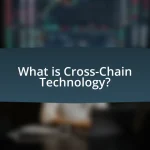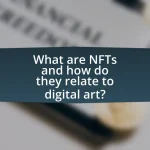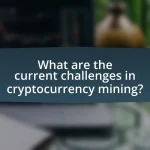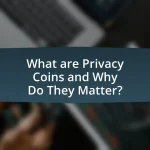The article examines how NFT market dynamics are reshaping traditional art sales by introducing new revenue streams and altering ownership models. It highlights the advantages of NFTs for artists, such as direct sales and ongoing royalties, while also discussing the key characteristics of the NFT market, including digital ownership, scarcity, and provenance. The piece further explores the differences between NFTs and traditional art forms, the role of blockchain technology, and the impact of NFTs on consumer behavior and pricing strategies in the art market. Additionally, it addresses the challenges faced by traditional galleries and artists in adapting to this evolving landscape, as well as future trends and best practices for both artists and collectors.

How are NFT Market Dynamics Reshaping Traditional Art Sales?
NFT market dynamics are reshaping traditional art sales by introducing new revenue streams and altering the ownership model. The rise of NFTs allows artists to sell digital art directly to consumers, bypassing traditional galleries and auction houses, which historically took significant commissions. This shift has been evidenced by high-profile NFT sales, such as Beeple’s “Everydays: The First 5000 Days,” which sold for $69 million at Christie’s in March 2021, demonstrating the potential for digital art to achieve prices comparable to traditional works. Additionally, NFTs provide artists with the ability to earn royalties on secondary sales, a feature not typically available in traditional art markets, thus creating ongoing income opportunities. This transformation is attracting a new generation of collectors who are more comfortable with digital assets, further influencing the landscape of art sales.
What are the key characteristics of the NFT market?
The key characteristics of the NFT market include digital ownership, scarcity, and provenance. Digital ownership is established through blockchain technology, which verifies that an NFT is unique and owned by a specific individual. Scarcity is created by limiting the number of copies of a digital asset, often resulting in higher demand and value. Provenance refers to the ability to trace the history of an NFT, providing transparency about its creation and ownership, which enhances its appeal to collectors. These characteristics contribute to the NFT market’s rapid growth and its impact on traditional art sales, as artists and collectors explore new avenues for monetization and investment.
How do NFTs differ from traditional art forms?
NFTs differ from traditional art forms primarily in their digital nature and ownership verification through blockchain technology. Traditional art is typically a physical object, such as a painting or sculpture, that can be owned, displayed, and sold, while NFTs exist as unique digital assets that represent ownership of digital items, such as images, videos, or music. The blockchain provides a transparent and immutable record of ownership and provenance for NFTs, which is not inherently available for traditional art, where authenticity can be harder to verify. This technological foundation allows NFTs to be easily traded on various online platforms, expanding their market reach compared to traditional art, which often relies on galleries and auctions for sales.
What role do blockchain technologies play in the NFT market?
Blockchain technologies serve as the foundational infrastructure for the NFT market by providing a decentralized and secure method for verifying ownership and authenticity of digital assets. Each NFT is recorded on a blockchain, ensuring that ownership history is transparent and immutable, which is crucial for establishing provenance in the art world. For instance, Ethereum, the most widely used blockchain for NFTs, utilizes smart contracts to automate transactions and enforce ownership rights, thereby reducing the risk of fraud. This technological framework not only enhances trust among buyers and sellers but also facilitates the creation of unique digital art pieces that can be easily traded, thus influencing traditional art sales by introducing new revenue streams and market dynamics.
Why are artists and collectors turning to NFTs?
Artists and collectors are turning to NFTs primarily for the ability to establish ownership and provenance of digital art. NFTs provide a unique, verifiable digital certificate that confirms authenticity and ownership, which is crucial in a market where digital works can be easily copied. This technology allows artists to monetize their work directly, bypassing traditional galleries and auction houses, thus retaining a larger share of profits. Additionally, NFTs enable artists to earn royalties on secondary sales, creating a continuous revenue stream. The growing acceptance of NFTs in the art world is evidenced by high-profile sales, such as Beeple’s digital artwork selling for $69 million at Christie’s in March 2021, highlighting the potential for significant financial gain and market validation.
What advantages do NFTs offer to artists compared to traditional sales?
NFTs offer artists greater control over their work and potential for ongoing revenue compared to traditional sales. Unlike traditional art sales, where artists receive a one-time payment, NFTs enable artists to earn royalties on secondary sales, ensuring they benefit from the increasing value of their work. Additionally, NFTs provide a direct connection between artists and collectors, eliminating intermediaries and allowing for a more transparent transaction process. This shift can lead to higher profit margins for artists, as they retain a larger share of the sale price. Furthermore, the digital nature of NFTs allows for global reach, enabling artists to access a wider audience without geographical limitations.
How do NFTs enhance the collector’s experience?
NFTs enhance the collector’s experience by providing verifiable ownership and provenance of digital assets. This technology allows collectors to authenticate their purchases, ensuring that they own unique items that cannot be duplicated. Additionally, NFTs often include metadata that can provide context about the artwork, such as the artist’s background and the creation process, enriching the collector’s understanding and appreciation of the piece. The blockchain technology underlying NFTs guarantees transparency and security, which fosters trust in transactions. According to a report by NonFungible.com, the NFT market reached a valuation of over $10 billion in 2021, indicating a growing interest and engagement among collectors.
What challenges do traditional art sales face due to NFTs?
Traditional art sales face significant challenges due to the rise of NFTs, primarily in terms of market competition and valuation. The introduction of NFTs has created a new digital marketplace that attracts collectors and investors, often diverting attention and funds away from traditional art forms. This shift has led to a decrease in demand for physical artworks, as buyers are increasingly drawn to the perceived uniqueness and investment potential of digital assets.
Additionally, the valuation of traditional art has become more complex, as the NFT market operates on different principles, such as scarcity and provenance tracked on blockchain technology. This has resulted in traditional artworks being compared unfavorably to NFTs, which can be sold at high prices despite their digital nature. The traditional art market also struggles with the speed and accessibility of NFT transactions, which can occur instantaneously online, contrasting with the slower, more cumbersome processes of traditional art sales.
These dynamics have forced galleries and artists to adapt their business models, often leading to increased competition and pressure to innovate in order to retain relevance in an evolving market landscape.
How are traditional galleries adapting to the rise of NFTs?
Traditional galleries are adapting to the rise of NFTs by incorporating digital art into their exhibitions and expanding their sales platforms to include online marketplaces. This shift allows galleries to reach a broader audience and engage with the growing community of digital collectors. For instance, prominent galleries like Pace and Hauser & Wirth have hosted NFT exhibitions and partnered with blockchain platforms to facilitate sales, demonstrating a commitment to embracing digital innovation in the art world.
What impact do NFTs have on the valuation of traditional artworks?
NFTs significantly enhance the valuation of traditional artworks by creating new revenue streams and increasing market visibility. The introduction of NFTs allows artists to tokenize their work, which can lead to higher prices due to the perceived scarcity and uniqueness associated with digital ownership. For instance, the sale of Beeple’s digital artwork for $69 million at Christie’s in 2021 exemplifies how NFTs can elevate the status and market value of both digital and traditional art forms. This phenomenon has prompted collectors to reassess the worth of traditional artworks, often leading to increased demand and higher auction prices as the art market adapts to the digital age.

How do NFT Market Trends Influence Consumer Behavior in Art Sales?
NFT market trends significantly influence consumer behavior in art sales by shifting perceptions of value and ownership. As NFTs establish a new paradigm for digital ownership, traditional art buyers increasingly view digital art as a legitimate investment, leading to a rise in demand for both NFTs and physical artworks. For instance, a report by NonFungible.com indicated that NFT sales reached $10.7 billion in Q3 2021, showcasing a growing interest that spills over into traditional art markets. This trend encourages collectors to diversify their portfolios, blending traditional and digital art, ultimately reshaping purchasing decisions and market dynamics.
What demographic shifts are occurring in art collecting due to NFTs?
Demographic shifts in art collecting due to NFTs include an increase in younger collectors and a more diverse range of participants. The rise of NFTs has attracted millennials and Gen Z, who are more comfortable with digital assets and technology. According to a report by Art Basel and UBS, 63% of collectors under 40 are now engaging with NFTs, indicating a significant generational shift in the art market. Additionally, the accessibility of NFTs has broadened the demographic landscape, allowing individuals from various backgrounds to participate in art collecting, which was traditionally dominated by older, affluent collectors. This shift is reshaping the art market by introducing new perspectives and values associated with digital art.
How are younger generations engaging with art through NFTs?
Younger generations are engaging with art through NFTs by actively purchasing, creating, and trading digital artworks on blockchain platforms. This engagement is driven by the appeal of ownership and authenticity that NFTs provide, allowing young artists to monetize their work directly without traditional intermediaries. According to a report by NonFungible.com, the NFT market saw a significant increase in participation from younger demographics, with 63% of NFT buyers being under the age of 35 in 2021. This trend highlights a shift in how art is consumed and valued, as younger generations prioritize digital assets and the unique experiences associated with them.
What factors drive consumer interest in NFT art?
Consumer interest in NFT art is primarily driven by the uniqueness and scarcity of digital assets, which are secured through blockchain technology. This technology ensures provenance and ownership, making NFTs appealing to collectors who value authenticity. Additionally, the growing acceptance of digital art in mainstream culture, coupled with the potential for high returns on investment, further fuels consumer interest. According to a report by NonFungible.com, the NFT market saw a significant increase in sales, reaching over $10 billion in 2021, highlighting the rising demand and interest among consumers.
How do NFT sales affect pricing strategies in traditional art markets?
NFT sales significantly influence pricing strategies in traditional art markets by introducing new valuation metrics and altering collector behavior. The emergence of NFTs has created a digital scarcity that traditional art markets must now contend with, leading to a reevaluation of how artworks are priced. For instance, the high prices achieved by NFTs, such as Beeple’s “Everydays: The First 5000 Days,” which sold for $69 million, have prompted traditional artists and galleries to adjust their pricing models to remain competitive. Additionally, the transparency of blockchain technology allows for more accessible price histories, enabling collectors to make informed decisions based on past sales data. This shift encourages traditional artists to adopt similar strategies, such as limited editions and unique offerings, to enhance perceived value and attract buyers who are now accustomed to the NFT market’s dynamics.
What pricing models are emerging in the NFT space?
Emerging pricing models in the NFT space include fixed pricing, auction-based pricing, and fractional ownership. Fixed pricing allows creators to set a specific price for their NFTs, which simplifies the purchasing process. Auction-based pricing, popularized by platforms like Sotheby’s and Christie’s, enables buyers to bid on NFTs, potentially driving prices higher based on demand. Fractional ownership allows multiple buyers to own a share of a high-value NFT, making it more accessible and diversifying ownership. These models reflect the evolving dynamics of the NFT market, influencing how traditional art sales are conducted by introducing new methods of valuation and ownership.
How do these models compare to traditional art pricing strategies?
NFT pricing models differ significantly from traditional art pricing strategies by emphasizing market demand and scarcity through blockchain technology. Traditional art pricing often relies on historical sales data, artist reputation, and gallery influence, whereas NFT models leverage real-time market dynamics and digital ownership verification. For instance, the NFT market can see rapid price fluctuations based on trends and social media influence, contrasting with the more stable and slower-moving traditional art market. This shift is evidenced by the record sales of digital artworks, such as Beeple’s “Everydays: The First 5000 Days,” which sold for $69 million at auction, highlighting how digital assets can command prices that rival traditional masterpieces.

What Future Trends Can We Expect in the Intersection of NFTs and Traditional Art?
The future trends at the intersection of NFTs and traditional art include increased collaboration between digital and physical artists, the rise of hybrid art forms, and enhanced provenance tracking through blockchain technology. As artists explore the potential of NFTs, they are likely to create works that blend traditional techniques with digital elements, appealing to a broader audience. Additionally, the use of blockchain for provenance will provide buyers with verifiable ownership history, which can enhance the value of traditional artworks. According to a report by Art Basel and UBS, the global art market reached $65.1 billion in 2019, and the integration of NFTs is expected to further expand this market by attracting tech-savvy collectors and investors.
How might the relationship between NFTs and traditional art evolve?
The relationship between NFTs and traditional art is likely to evolve towards greater integration and collaboration. As artists increasingly adopt NFTs to enhance their visibility and reach, traditional art institutions may begin to embrace digital formats, creating hybrid exhibitions that showcase both physical and digital works. This shift is supported by the growing acceptance of NFTs in mainstream art markets, evidenced by high-profile auctions at established houses like Christie’s and Sotheby’s, which have sold NFT artworks for millions, indicating a merging of digital and traditional art valuation.
What innovations could emerge from the fusion of these two markets?
The fusion of the NFT market and traditional art sales could lead to innovations such as enhanced provenance tracking and fractional ownership models. Enhanced provenance tracking utilizes blockchain technology to provide verifiable ownership history, ensuring authenticity and reducing forgery risks, which is crucial in the traditional art market where provenance is a key factor in valuation. Fractional ownership models allow multiple investors to own shares of high-value artworks, democratizing access to art investment and enabling a broader audience to participate in the art market. This approach has already been seen in platforms like Masterworks, which allows investors to buy shares in blue-chip artworks, illustrating the potential for increased liquidity and investment opportunities in traditional art through NFT integration.
How can traditional artists leverage NFTs for their benefit?
Traditional artists can leverage NFTs by creating digital representations of their artwork, allowing them to sell directly to collectors without intermediaries. This approach enables artists to reach a global audience, increasing their visibility and potential sales. Additionally, NFTs provide artists with the ability to earn royalties on secondary sales, ensuring they benefit financially from the ongoing appreciation of their work. The NFT market has seen significant growth, with sales reaching over $10 billion in 2021, demonstrating the increasing demand for digital art and the opportunities it presents for traditional artists.
What best practices should artists and collectors consider in this new landscape?
Artists and collectors should prioritize transparency and authenticity in the evolving landscape of art influenced by NFTs. Transparency involves clear communication regarding the provenance and ownership of artworks, which is crucial in building trust within the community. Authenticity can be ensured through the use of blockchain technology, which provides verifiable proof of ownership and originality.
Additionally, artists should engage with digital platforms to reach broader audiences, as the NFT market has expanded the potential for visibility and sales. Collectors, on the other hand, should educate themselves about the digital art space and the implications of blockchain technology to make informed purchasing decisions.
Research indicates that the integration of NFTs into traditional art markets has led to increased sales and interest, with a report from Art Basel and UBS noting that the global art market reached $65.1 billion in 2018, with a significant portion attributed to digital art sales. This data underscores the importance of adapting to new market dynamics for both artists and collectors.
How can artists effectively market their NFT artworks?
Artists can effectively market their NFT artworks by leveraging social media platforms, engaging with online communities, and collaborating with influencers in the NFT space. Social media channels like Twitter, Instagram, and Discord are crucial for building a following and showcasing artwork, as they allow artists to connect directly with potential buyers and collectors. Engaging with communities on platforms such as Discord or Reddit helps artists gain visibility and credibility within the NFT ecosystem. Collaborating with influencers can amplify reach, as these individuals often have established audiences interested in digital art and NFTs. According to a report by NonFungible.com, successful NFT sales often correlate with strong community engagement and social media presence, highlighting the importance of these marketing strategies.
What precautions should collectors take when investing in NFTs?
Collectors should conduct thorough research on the NFT’s provenance and the credibility of the creator before investing. This includes verifying the authenticity of the digital asset, understanding the market demand, and assessing the potential for future value appreciation. According to a report by NonFungible.com, the NFT market has seen significant fluctuations, with some assets losing value rapidly, highlighting the importance of due diligence. Additionally, collectors should be aware of the risks associated with smart contracts and the potential for scams, as the decentralized nature of blockchain technology can sometimes lead to fraudulent activities.










